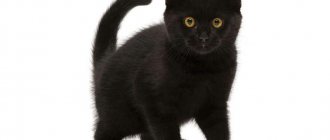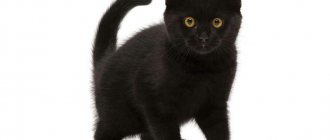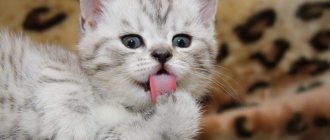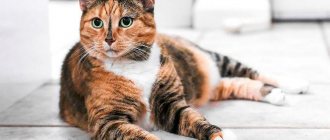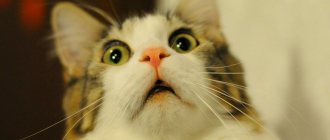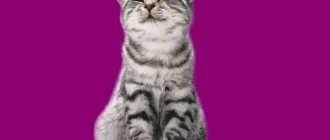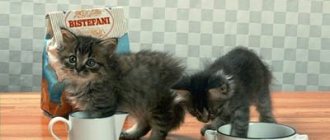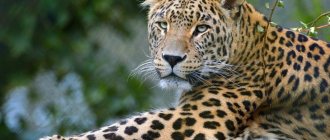Nature has endowed all cats with a difficult character, but black cats are also distinguished by their unusual appearance. People blame these animals for all misfortunes and superstitiously try not to cross them on the road.
Apparently, this is how the subconscious fear of the dizzying beauty of animals in shiny coal-colored coats is expressed. But this color in different combinations is found in almost all cat breeds.
Genetics of black color
The pigment pheomelanin is responsible for the red color, and eumelanin is responsible for the black color. In cat hair they are presented in the form of granules, the shape, quantity and location of which determine the color shade. Let’s leave the first one (red) aside, and consider the second one in detail.
- In black cat breeds, the B (black) gene is responsible for color. In the genotype of an animal, it can be represented in three alleles (species): dominant B, recessive b and bl.
- In the dominant state, the gene forms almost round (slightly elongated at the poles) eumelanin granules with a dense arrangement in the hairs. This gives a rich black color.
- The recessive allele b of the same gene stretches the pigment granules and moves them away from each other. It turns out to be a chocolate shade.
- The final form of bl is even more expanded eumelanin capsules and a sparse arrangement. On the hair this gives the color of cinnamon (cinnamon), characteristic of many breeds.
All other characteristics do not play a role in the color of interest - a large black cat is necessarily a carrier of the dominant B gene.
This is interesting! In black cats, there is no relationship between coat color and the sex of the animal. Their genes are not connected to the chromosomes that are responsible for dividing into “boys” and “girls.”
What do black cats symbolize?
It is difficult to find animals with such a controversial image as black cats. In the mythology of various peoples they are depicted ambiguously:
- In Ancient Egypt they were treated with respect and considered the incarnation of the goddess Bast. For deliberately killing this animal, the criminal could be sentenced to death. Local residents took black pets into their homes and believed that they, like pieces of the soul of a deity, brought good luck. The love for black cats was so strong that after death they were mummified and then mourned as if they were family members.
- Only a person with a wild imagination and vivid imagination is able to discern a fiend from hell in a cat. It is unknown what reasons led Pope George IX to outlaw black cats in 1234. The head of the Roman Catholic Church publicly declared that these animals are the embodiment of Satan, and called on his flock to exterminate them.
- In Rus', cats with dark fur were treated favorably. These animals were considered not only excellent mouse catchers, but also reliable defenders of the home from evil forces. In Slavic culture, their image was closely intertwined with the phenomenon of the brownie. Therefore, before moving into a new hut, a furry animal was first let into the room so that it would make friends with the domestic spirit.
Characteristic eye color
The genetics of the pupil is less studied than the properties of fur. Researchers suggest the presence of a color gene and some polygenes that are located outside the studied structures and affect the characteristic features of the organism.
Felinologists identify three most common combinations:
- Black cats with green (grn) eyes are a classic color combination.
- The second group is orange, brown and amber-honey (org) eyes.
- The final position is in the copper color range (cpr). Fairytale black cats with red eyes actually come from this category.
When recessive alleles (b, bl) come into play and various shades appear on the cat's coat, the pupil color combinations automatically dilate. But absolutely black cats have only the three listed eye colors.
This is interesting! Black coat color is never ideal. It all depends only on the degree of its saturation, which hides some natural pigmentation flaws.
Russian folk signs
Black German Shepherd: characteristics, what is it called
According to Russian folk beliefs, if a black cat crosses the road, trouble awaits. Misfortune can also befall if your four-legged friend runs into your bosom. However, you can protect yourself from misfortunes by spitting 3 times over your left shoulder, twisting the barrel and grabbing a button.
There are other Russian folk signs:
- When a strange black cat appears in the house, you should expect trouble.
- If you dream of a black cat the night before Christmas, it means that the person will become seriously ill.
- It will be much more difficult for thieves to get into a house if a charcoal-colored cat lives in it.
- A sick person can die if a black cat enters his room.
Bombay cat: black standard breed
Bombays are short-haired black cats, fit, graceful, with shiny golden-copper eyes. Their coat has a glossy satin texture, it is evenly colored along the entire length of the hair and lies tightly to the body. The long tail makes the miniature animal look like a wild predator.
The selection was carried out in the USA, where felinologists pursued two goals. Firstly, this is the desire to consolidate the obligatory black color in hereditary characteristics. Secondly, they wanted to obtain an external resemblance to a panther.
The parent breeds were Burmese and representatives of the American Shorthair cat. It took 4 generations of kittens to breed to achieve a positive result.
Bombays are called the most beautiful black cats. Their color must be uniform from root to tip, and uncolored white patches are considered a serious reason for disqualification.
This is interesting! Bombay kittens are born with small spots and bright blue eyes. As they grow older, the animals change color, get rid of alien light patches on their coats, and the color of their eyes becomes golden.
Breeds with acceptable black coloration
In nature, this color is not unique among cats and is often found in any breeding groups. The dominant B gene is stably present both in native breeds (which were formed under natural conditions) and in various hybrid communities or among outbred animals.
big black cats coexist with equally charcoal-shiny homeless strays, and this picture never surprises anyone.
American Bobtail
A rare breed of tailless cats. Their breeding began in the 60s in Arizona and continues to the present day. Among the parents of the American Bobtail are Siamese, Burmese, and Himalayan cats. A distinctive feature of the breed is the absence of a tail, and the color fades into the background.
More often than others, grey-red kittens with a tabby pattern (stripes and spots) are born. Fluffy black cats with a small overgrown tassel in place of the tail are less common, but it all depends on the parents and genetic predisposition.
The mixture of different breeds in the origin of the American Bobtail suggests the appearance of offspring of the most unusual colors, among which there are both solid black colors and combinations of black and white.
Siberian breed: black cat with green eyes
An indigenous Russian cat, which can be recognized as a national treasure of the country. The history of origin is unknown for certain, like most other breeds. But rich long fur, dense undercoat and adaptability to harsh climates indicate that the animal has perfectly adapted to its natural habitat.
The solid colors of Siberians come in two colors: red and black. But if the red tones are intersected by a tabby pattern (stripes, spots or blurred marble), then the coat of a long-haired black cat looks very impressive. In total there are more than 200 combined color options.
This is interesting! Siberian cats became the founders of the Neva Masquerade subspecies - a long-haired breed with a characteristic point mask in red or black shades.
Oriental cat
Oriental cats are champions among black breeds in terms of gracefulness. They are very graceful and sophisticated, on high slender legs, with an elongated wedge-shaped muzzle on a long neck and slightly slanting green eyes. In this color, the wool is evenly dyed along the entire length, from the root to the end.
Among representatives of this species, smooth-haired black cats are also often found.
Devon Rex
Devon Rexes are presented in two categories:
- Like many new breeds that gained official recognition in the 20th century, all modern Devons are descended from a kitten found in the litter of a mongrel cat. He had very large ears and curled fur, for these qualities the cat received the name Kirli (curly).
- It is a rare case when literally everything is known about the first animal in the group - Kirli was a black cat with eyes the shade of yellow amber.
Devons are very active pets - they love to climb onto the owner's neck and sit on his shoulders.
Like other representatives of the “eared” group, they are often called elves, hinting at “extraterrestrial” genetics. Among the popular black cat breeds, Devon cats are not considered. The population is small and black is not the most common color.
Turkish Angora
For more than a century, Turkey has had a program to preserve this breed as a national treasure. We are talking about a classic Angora cat with long or semi-long white hair and multi-colored eyes - yellow and green.
These animals began to be called Angora due to their very soft hair, by analogy with the well-known downy goat breed.
The spread around the world and the efforts of breeders have not benefited the classic white color. It is gradually giving way to other colors, and it is not surprising when black-brown cats with different-colored eyes and a fluffy long tail appear at exhibitions.
It must be admitted that in the pure black version, the shaggy Turkish Angora looks very impressive and rich.
Norwegian forest
Representatives of the aboriginal breed live in Northern Europe. One of the legends about its appearance connects the harsh, unpretentious Norwegians with the pampered southern Angora breed, which has adapted to living conditions in a cold climate.
The forest cat is large, with a double coat, dense undercoat and winter “decorations”: a mane, bib, whiskers and warm pants on the hind legs.
The portrait is completed by neat erect ears with tassels and thick pubescence on the inside of the auricle.
Norwegians are large animals that mature only at 4-5 years of age. Any color is allowed in the breed except those that indicate an undesirable crossbreed: fawn, cinnamon, chocolate and others. Large all-black cats are rare, but black and white cats with thick undercoat are common.
This is interesting! The indigenous qualities of the Norwegian forest cat are protected by an international association. Their out-of-breed crossings are allowed only with a separate permission from WCF.
American Curl
There are representatives of this breed with semi-long and short hair. A distinctive feature of Curls are their ears - wide at the base, semicircular at the top, with reverse folded ears at an angle of at least 90°.
There are no separate requirements for coat and eye color, with the exception of color-point colors with a characteristic blue eye color. In other colors, shades from brown to light hazel are acceptable.
Representatives of this breed with pure black hair are rare. The most beautiful black cats come from short-haired parents. Long-haired pets are traditionally presented in black and white.
Important! The American Curl should not be left alone with small children. Careless caresses can damage the fragile structure of the curled ears.
Manx
The main distinguishing feature of the Manx cat is the absence of a tail. The length of what is left of it cannot extend below the hock joint of the hind legs. But more often there are animals with a 3-7 cm “process”.
When breeding animals, they must select one of the parents with a longer tail - two tailless genes lead to the death of the offspring.
Manx cats are allowed any coat color, except for the color-point varieties. Black kittens are rare, but white or tortoiseshell cats are born consistently.
Cymric
The Cimmerian breed is a semi-longhaired version of the Manx. Breeders united kittens with long hair into a separate group, and then they were recognized by international felinological unions.
Black tailless Cymric cats are born with yellow or green eyes and the typical short "broom" for a tail. They easily adapt to the family and get along well with children and pets.
Coal Bengal
To call this cat black is wrong, but to describe it in any other way is stupid. Bengals are an interspecies mix. Their ancestors are domestic cats and wild Bengal cats. The hybrid received an incredibly beautiful spotted color - contrasting black spots on a golden background.
In appearance, they resemble small leopards with a cute face and an independent character.
The Charcoal Bengal's main coat color is bleached black, and the spots and stripes are less pronounced. Another feature of the animal’s appearance is the mask on its face. Its lines are wider than those of standard-colored cats.
Charcoal Bengal charcoals do not have any privileges in the standard and are subject to general expert rules.
Chausie
Another hybrid of a domestic cat (this time an Abyssinian) and a wild jungle cat. The desire to breed a harmless animal with the external signs of a predatory animal does not leave breeders, and they are finding more and more sophisticated ways. Chausie (housey) is another experiment in this chain.
This breed has only three colors:
- silver;
- tabby;
- black.
It is not recommended to keep Chausies in an apartment, as they need space to play and move.
The character of the "blackies"
Despite prejudices, black cats feel people, their emotions and mood very well. It is not for nothing that they have become an integral attribute of witchcraft. The question arises: why exactly black cats became a magical symbol. It turns out that dark color indeed absorbs negative energy, preventing energy vampires from entering the biofield.
Cats have telepathic abilities, this has been scientifically proven. In relationships with humans, black cats are a kind of barometer. They sense the owner's mood well. Their bioenergy combined with charcoal color gives an amazing result, especially if the pet has an easy-going character.
Black cats not only perfectly relieve nervous stress, but also treat cardiovascular diseases. Doctors recommend getting such a kitten to reduce the risk of a heart attack. If you stroke a pet of a calm nature, tension is relieved and blood pressure normalizes.
By nature, black cats are sociable, playful, and get along well with children. They are physically active with a pronounced hunting instinct. Black kittens love to play with their owner's ball or slipper. Not only a kitten, but also an adult cat with blue eyes can chase a flying fly.
Other breeds of black cats
Cats with black fur are found in almost all aboriginal groups. The Maine Coon is a very interesting breed - a champion in height, length and weight. It is in this breed that huge black cats in solid color or with white accents are often found.
Unlike the newly bred mestizos, all natives are good-natured, loyal to people and endowed with good health. The only difficulty is breeding. International expert organizations require compliance with the rules for crossing with other breeds.
Grooming
Hair care for cats depends on the breed and physical condition of the animal.
- Long-haired and semi-long-haired pets need regular brushing. The procedure must be repeated daily, and during molting - several times a day.
- When caring for a black cat with short hair, special combs and brushes are used that collect small hairs.
Important! The “fur coat” of any cat is an indicator of its health. If the fur loses its shine or falls out excessively, you need to reconsider the animal’s diet and show your pet to a veterinarian.
How to care for a black British man
The popularity of Black British dogs is explained not only by their spectacular appearance and positive character, but also by the ease of keeping this breed at home.
Hygiene
The coat of Black British cats is easier to care for than that of other representatives of the breed, since it is stiff and elastic, gets dirty less and is easier to clean itself. Some owners argue that these cats don’t need to be bathed at all - they themselves perfectly resolve all issues of their own hygiene. But it is not so.
Yes, the British constantly monitor the cleanliness of their fur coat, but sometimes it still needs to be washed using special cat shampoos. They are bathed infrequently - once every six months. An exception to this rule is when preparing for a show or when your pet's fur is very dirty.
Black British cats love to wash themselves
Human shampoos cannot be used on cats - dandruff or allergic reactions and dermatoses may occur. Black British cats do well with cat shampoos for dark coats. Various manufacturers have such cosmetics, but it is better to give preference to expensive brands - cheaper options can deprive the British fur of its wonderful shine.
Advice from my own experience: a brownish tint on black wool can be eliminated by using shampoos... for white wool. These products usually do not have a banal lightening effect - but they effectively remove all elements of yellowness and brownness from the fur, making the natural color brighter. When choosing such a shampoo, pay attention to its composition - the more natural it is, the better.
Don't bathe your pet too often - it won't benefit his coat.
For British Shorthairs, one brushing per week is enough; shedding hair needs to be brushed more often. During periods of seasonal molting, the fur coat should be combed three times a week using a furminator. At this time, it is recommended to introduce vitamin supplements into the diet that are produced specifically for this breed.
Ears, eyes, teeth and claws require special attention - everything that the animal cannot care for on its own. Ordinary hygiene involves wiping the inner surface of the ears and the perimeter around the eyes with cotton pads lightly dipped in cool boiled water or a special lotion.
Eyes need to be cleaned daily, ears weekly, without going deep into the ear canal. To clean teeth, use special pastes and brushes that are sold in pet stores. Claws, if they do not grind down on their own, are trimmed as they grow. It is advisable to lubricate the claw sections with antifungal drugs.
Feeding
The British can boast of an excellent appetite and pickiness in food. The black Briton is by no means an exception in this sense. Both high-quality dry food and natural nutrition are suitable for him. The pet industry offers a large selection of ready-made foods designed specifically for British cats - they are available in the lines of many well-known brands.
If your pets are sterilized or lead a sedentary lifestyle, you will need to pay special attention to the selection of food - it should be of high quality, but low in calories. It is impossible to overfeed the British, representatives of this breed are prone to obesity. But water, fresh and clean, should always be in sufficient quantities.
It is more difficult to choose a natural diet for a black Briton - so that it is healthy, varied and balanced. It is recommended to include the following products in the cat's menu:
- boneless veal or poultry;
- boiled sea fish;
- low-fat fermented milk products;
- quail eggs;
- boiled or fresh vegetables.
Fresh meat should make up at least half of a black Briton's diet
It is very useful to give your pet seaweed - kelp - once a week, which helps improve the quality of the coat and saturate the black color. Important: kelp must be fresh or dried - pickled seaweed should not be given. Pickled, spicy, smoked, fatty and fried foods are harmful to cat digestion. You also can’t “pamper” the British with sweets and fresh baked goods.
Toilet
Smart British kittens start using the litter box early. They are very clean and easy to train, so in their new place of residence there are usually no problems in this regard. The only thing worth paying attention to is that the tray should be quite spacious and comfortable, since British cats have impressive dimensions. Usually, closed toilets are purchased for this breed.
Trust the choice of litter for the tray to the preferences of your pet. Find out in a timely manner from the breeder what type of litter the kitten has gotten used to, and buy the same one for him.
For long-haired British cats, wood and low-quality mineral fillers are not recommended - when wet, they turn into a sticky substance that stains the elongated fur on the paws and then spreads throughout the house.
